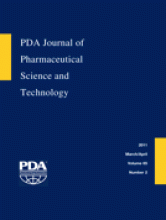Abstract
Owing to the high costs associated with biopharmaceutical development, considerable pressure has developed for the biopharmaceutical industry to increase productivity by becoming more lean and flexible. The ability to reuse knowledge was identified as one key advantage to streamline productivity, efficiently use resources, and ultimately perform better than the competition. A knowledge management (KM) strategy was assembled for bioprocess-related information using the technique of Design-for-Six-Sigma (DFSS). This strategy supported quality-by-design and process validation efforts for pipeline as well as licensed products. The DFSS technique was selected because it was both streamlined and efficient. These characteristics permitted development of a KM strategy with minimized team leader and team member resources. DFSS also placed a high emphasis on the voice of the customer, information considered crucial to the selection of solutions most appropriate for the current knowledge-based challenges of the organization.
The KM strategy developed was comprised of nine workstreams, constructed from related solution buckets which in turn were assembled from the individual solution tasks that were identified. Each workstream's detailed design was evaluated against published and established best practices, as well as the KM strategy project charter and design inputs. Gaps and risks were identified and mitigated as necessary to improve the robustness of the proposed strategy. Aggregated resources (specifically expense/capital funds and staff) and timing were estimated to obtain vital management sponsorship for implementation. Where possible, existing governance and divisional/corporate information technology efforts were leveraged to minimize the additional bioprocess resources required for implementation. Finally, leading and lagging indicator metrics were selected to track the success of pilots and eventual implementation.
LAY ABSTRACT: A knowledge management framework was assembled for bioprocess-related information using a streamlined and efficient technique that minimized team leader and member resources. The technique also highly emphasized input from the staff, who generated and used the knowledge, information considered crucial to selection of solutions most appropriate for the current knowledge-based challenges in the organization.
The framework developed was comprised of nine workstreams, constructed from related solution buckets which were assembled from individual solution tasks that were identified. Each workstream's detailed design was evaluated against published and established best practices, as well as the project charter and design inputs. Gaps and risks were identified and mitigated to improve robustness of the proposed framework. Aggregated resources (specifically expense/capital funds and staff) and timing were estimated to obtain vital management sponsorship for implementation. Where possible, existing governance and information technology efforts were leveraged to minimize additional bioprocess resources required for implementation. Finally, metrics were selected to track the success of pilots and eventual implementation.
- Knowledge management
- Biopharmaceuticals
- Bioprocess
- Process development
- Design-for-six-sigma
- Quality-by-design
- ©PDA, Inc. 2011
PDA members receive access to all articles published in the current year and previous volume year. Institutional subscribers received access to all content. Log in below to receive access to this article if you are either of these.
If you are neither or you are a PDA member trying to access an article outside of your membership license, then you must purchase access to this article (below). If you do not have a username or password for JPST, you will be required to create an account prior to purchasing.
Full issue PDFs are for PDA members only.
Note to pda.org users
The PDA and PDA bookstore websites (www.pda.org and www.pda.org/bookstore) are separate websites from the PDA JPST website. When you first join PDA, your initial UserID and Password are sent to HighWirePress to create your PDA JPST account. Subsequent UserrID and Password changes required at the PDA websites will not pass on to PDA JPST and vice versa. If you forget your PDA JPST UserID and/or Password, you can request help to retrieve UserID and reset Password below.






